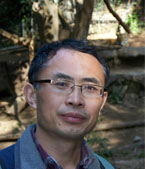
The 2nd International Conference on New Energy and Future Energy System
September 22nd - 25th, 2017, Kunming, Yunnan, China

 |
Dr. Wenzhe Tang Associate Professor and Director Institute of Project Management and Construction Technology Dept. of Hydraulic Engineering Tsinghua University, Beijing, China |
Keynote speech title: Road Map for Sustainable Hydropower Development of China Abstract: Sustainable hydropower development plays a critical role to reduce the environmental impacts arising from using fossil fuel. We presented solutions to sustainable hydropower development for China on three governance levels. At international level, China should establish partnering relationships with the neighboring countries to cooperatively manage the transboundary rivers associated with hydropower production, water sharing, environmental sustainability and climate change. China has a wealth of experience and technologies to contribute from its many previous hydropower projects. At the national level, there is a need to measure and understand the cascade effects of dams at river basin scale for optimizing the reservoir operation and environmental protection. Laws and regulations on hydroelectricity pricing and migrants' compensation standards should be reformed and updated. Inter-regional transfer payments to the local authorities for balancing social and environmental losses of affected areas need to be developed for equitably allocating benefits/rewards among stakeholders. At the project level, more attention should be paid to migrant resettlement, land planning, natural resource preservation, and enhancing input in infrastructure development. Government should help migrants with education, employment, and forming new social networks, without devaluing their livelihoods and social capital. The scheme has both research and policy implications. The approaches can not only help to choose appropriate low-carbon development strategies for China, but also be applicable to global river basin management and hydropower developments, especially in developing countries. |
|
 |
Dr. Joachim von Schéele Head of Steel, Metals & Glass Industries Asia Pacific The Linde Group Shanghai, China |
Keynote speech title: Short-term Opportunities to Decrease CO2 and NOx Emissions from the Steel and Metals Industries Abstract: The combustion processes in the heavy industries area are a large user of energy and source of emissions. Those are mainly applied for heating, melting, smelting, and reheating of the materials being produced. In general, China produces more than half of the world production of most main metals, for example, steel and aluminium, and two-thirds of the steel production is found in Asia. In China there are more than 120,000 industrial furnaces in operation. The energy use in those industrial furnaces accounts for more than 25% of the total energy use in China, and more than 60% of the energy use in its industry. Steel, non-ferrous metals, cement, and glass industries are the main energy users. More... |
|
 |
Prof. Shijie Liu Professor and Associate Chair Department of Paper and Bioprocess Engineering State University of New York New York, USA |
Keynote speech title: Ethanol Fermentation of Mixed Sugars from Woody Biomass Abstract: Woody biomass has becoming an attractive source of renewable energy and materials. Woody biomass is heterogeneous containing carbohydrates and aromatics. While glucose is the most preferred substrate for bioconversion, polymers of multiple sugars are found in woody biomass. Hot-water extraction of woodchips is a beneficial technique to pretreat woody biomass prior to its conversion to valuable products in a biorefinery. Hot water wood extract contains a mixture of sugars: xylose, glucose, galactose, mannose, arabinose and rhamnose, and their polymers. Five carbon sugars, for example, fetch a premium value over glucose. However, the sugar mixture as it is presents a challenge in fermentation to ethanol and other materials, chemicals, and / or biofuel. There is a preference of the sugars when a sugar mixture is presented to most microorganisms. The fermentation efficiency is especially low for xylose. When genetically modified E. coli fbr5 was employed to ferment the sugar mixture to ethanol, glucose was the first sugar consumed, and then galactose, arabinose, mannose and rhamnose, xylose was the last to be consumed. While E. coli fbr 5 was genetically engineered to ferment Xylose, this outcome is disappointing. Most microorganisms prefer glucose, E coli is no exception. Xylose is the least preferred sugar On the other hand, xylose can be employed to produce xylitol, furfural, and a lot more products efficiently. The value of xylose is higher than glucose on the market, and yet it is limiting the efficiency in biomass conversion. It is possible to leave xylose unconverted and separated from the fermentation broth, while improving fermentation efficiency. |
|